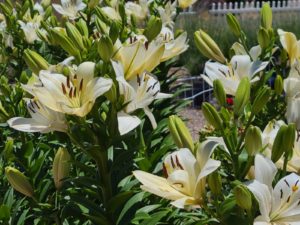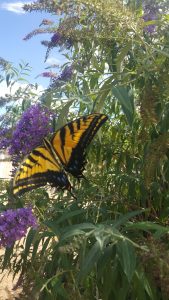Maintaining Our Gardens To Maximize Their Value as Habitat
by David Salman, Founder and Chief Horticulturalist for High Country Gardens
Fall is well underway and many of us are focused on getting our gardens and landscapes ready for their winter rest. Here is some guidance as to which plants need to be cut back in fall or winter and which should be left standing until spring. As I have said many times, with the effects of climate change already impacting our lives, we no longer have the luxury of gardening just for beauty. We must also plant and care for our landscapes to benefit the creatures that share our environment by providing habitat with our plant choices and maintenance methods. Here are some tips that will help to make your garden and landscape more “habitat friendly.”
- Winter is an ideal time for pruning woody plants that lose their leaves (deciduous) because they are dormant.
- Most fruit, flowering and shade trees all benefit from winter pruning to remove crossed branches, gently shape their branch structure and, with shade trees, maintaining strong non-forked leaders.
- But don’t shear the branches of spring flowering shrubs (Forsythia, Lilac, New Mexico Privet, Spirea, Flowering Quince and others), as this will remove the old wood (last year’s growth) that produces flowers in the spring.
- Summer blooming shrubs like Russian Sage (Perovskia), Blue Mist Spirea (Caryopteris) and Butterfly Bush (Buddleia davidii and hybrids) should be left untrimmed over the winter months.
- Russian Sage should be cut back hard in mid-spring, leaving stems 12-15″ tall. This should be done every spring to keep them blooming heavily.
- Blue Mist Spirea and Buddleia should be cut back by 1/3 to 1/2 of their height every third year (NOT annually) to re-invigorate the shrubs and encourage blooming.
- Leave these grasses standing over the winter months.
- Their foliage and seed heads offer us winter beauty when the low angled winter sunshine illuminates them.
- Wait until mid-spring to cut grasses back, as many beneficial insects use these grasses to provide protection for overwintering egg masses, larvae, and adult forms. This gives the insects time for their eggs to hatch and their larvae to change into adults.
- Birds will also utilize these standing grasses as sources for seed and winter shelter. Ground birds, like quail, will use large ornamental grasses for winter protection.
- Warm season grasses include Little Bluestem (Schizachyrium), Big Bluestem (Andropogon), ‘Blonde Ambition’ Blue Grama (Bouteloua), Muhly (Muhlenbergia), Prairie Switchgrass (Panicum), Chinese Maidenhair Grass (Miscanthus), Giant Sacatoon (Sporobolus wrightii) and others. They should be cut back in mid-spring.
- Cool season grasses, like Blue Avena Grass (Helictotrichon), Fescue grass (Festuca), Silky thread Grass (Nassella) and ‘Karl Foerster’ Feather Reed grass (Calamagrostis) have evergreen foliage that should not be cut to the ground. Instead vigorously “comb out” dead leaves with gloved hands and clip off the dead leaf tips. In early spring, clip off old seed head stalks as far down into the foliage as possible to leave room for late spring flowers.
- If the grass plant has a ring of living leaves with a dead center, it’s time to divide the grasses to re-invigorate them. (This is necessary once every three to five years depending on the species and growing conditions.)
- Leave perennials standing over the winter as well
- These plants will often provide the same shelter to beneficial insects as the ornamental grasses.
- Additionally, species with ornamental seed heads such as Yarrow (Achillea), Purple Coneflower (Echinacea), Tall Stonecrop (Sedum) and others with flat or cone-shaped dried flowers, add to the garden’s winter beauty.
- Seed bearing perennials such as Purple Coneflower (Echinacea), Joe Pye Weed (Eupatorium), Hummingbird Mint (Agastache), Lavender (Lavandula), perennial Sunflower (Helianthus) and others provide valuable winter food for songbirds.
- Perennials that are living at the edge of their cold hardiness are more cold hardy when their stems are left standing over the winter. So when native Sage (Salvia), Hummingbird Mint (Agastache), Hummingbird Trumpet (Zauschneria) are planted in USDA zones 5 & 6, this will help them survive the winter cold. This is especially true for young plants (in the ground one to two growing seasons).
- Wait until mid-spring to cut back perennials, unless the perennial plants are exhibiting some summer/fall disease or are infested with injurious insects. In these instances, these damaged plants should be cut back.
Leaves
- Leaves are a valuable resource for soil building and mulching. Don’t just throw them away.
- They should be raked from lawns, but utilized elsewhere in the landscape where they can be used as mulch under trees, shrubs and evergreens. Or rake them and put them through a shredder, so you can mulch perennial beds and vegetable gardens with the chopped-up foliage.
- In wetter climates, it’s best not to leave them on top of your untrimmed perennials and other flower beds as they will cause problems with fungus and rot. Instead, chop ’em up and use them as mulch to improve your soil.
Grass Meadows and Lawns
- Native (Buffalo and Blue Grama Grass) and Dog Tuff lawns should be given a last mowing in late Oct. But mow the grass high, leaving it about 4″ tall. Never scalp the lawn in the fall, as this weakens it and leaves the stems vulnerable to damage from cold and dry conditions.
- Meadows, like ornamental grasses and perennials, should also be left standing over the winter. Mow with the mower deck set high in mid-spring.



No comments.